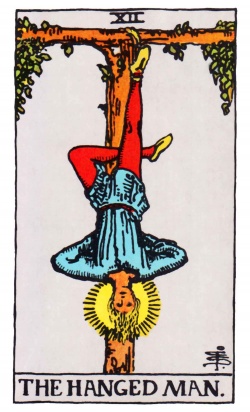The Hanged Man
An Avatar.Global Resource
The Hanged Man
The Hanged Man is an Old Energy Archetype from the Masonic Tarot Deck. In the Book of Slavery and Book of Power, the archetype is used as a threat of punishment, and also the importance of "absolute submission."[1]

List of Old Energy Archetypes from the Masonic Tarot
Chariot, Death (archetype), Duality, Hermit, Hierophant, High Priestess, Judgement, Justice, Star, Strength, Sun (archetype), Temperance, The Devil, The Emperor, The Empress, The Fool, The Hanged Man, The Lovers, The Magician, The Moon, The Tower, The Wheel of Fortune, The World (old energy)
Related Archetypal Constellations
Submission > Hierophant, The Fool, The Hanged Man
Notes
Book of Power
(The Hanged Man or self abnegation.) Initiating influence is worked mysteriously without recourse to profane means. It goes by unnoticed, for it is expressed neither in resounding speeches nor in actions which attract attention. Of his own free will the Initiate condemns himself to an apparent impotence which allows him to act as he wishes and with efficacy.[2]
"This Hanged Man serves for an example to the presumptuous, and his position indicates discipline, the absolute submission which the human owes to the Divine."[3] In the previous passage, notice both the threat of physical violence and the admonition to submit.
"But the revelation of the law involve punishment for him who violates it, or elevation for him who understands it; and here we find the ideas of punishment, of violent death, voluntary or involuntary." IOW, once the secrets are revealed, you better keep your mouth shut, or else.[4]
Book of Slavery
"This Hanged Man serves for an example to the presumptuous, and his position indicates discipline, the absolute submission which the human owes to the Divine."[5] In the previous passage, notice both the threat of physical violence and the admonition to submit.
"But the revelation of the law involve punishment for him who violates it, or elevation for him who understands it; and here we find the ideas of punishment, of violent death, voluntary or involuntary." IOW, once the secrets are revealed, you better keep your mouth shut, or else.[6]
Excuse and Justification: "Beyond all its symbolism the Hanged Man affects us because it shows a direct image of peace and understanding. The calm shows so strongly in the card because the Hanged Man has surrendered to the rhythms of life."[7]
Justification for suffering. "He reminds us of Prometheus, who was chained to a rock as a punishment for stealing fire from the gods and giving it to man kind. So we have a divine being, an immortal, imprisoned in matter, bound to the cross of reality. But was it punishment? Or is that a fable, invented by guilt-plagued men? For Prometheus is the divine creator of man, he does not suffer, he cannot be punished. In Actualism, it is taught that we suffer pain only if we identify with the body, the creation, in stead of with the divine creator within (Prometheus )." [8]
"No longer does he perceive the universe as a warring, separative multiplicity of things and conditions. He sees it instead as a unity which manifests itself as a succession of harmoniously related parts, none of which stands alone and all of which are sustained as the expression of that Unity in its entirety. No matter where he may be, no matter how things may seem, he is consciously aware that "all the power that ever was or will be is here, now." [9]
Psychological theory: Represents Samadhi/union. "This is precisely what the Hanged Man typifies. When concentration is prolonged, the effect produced is what the Hindus call Samadhi, or the Super-conscious state of existence. It is the perfect union of the personal consciousness with the universal, attained by practices which quiet the mind, and suspend the formation of association of ideas." [10]
"The Psychological Mode of Expression shows a shattering of one's previous belief structure and opting for a new one. In many ways, it is the rebirth principle and for the Eastern system of beliefs it is allied with reaching a certain level of enlightenment." [11]
"The Hanged Man depicts a nightmare type journey in which he has to confront not only his own feelings and emotions but a whole belief structure that surrounds him."[12]
Citation and Legal
Treat the SpiritWiki as an open-access online monograph or structured textbook. You may freely use information in the SpiritWiki; however, attribution, citation, and/or direct linking are ethically required.
Footnotes
- ↑ Papus, The Tarot of the Bohemians (Wilshire Book Co, 1978), https://sacred-texts.com/tarot/tob/index.htm.
- ↑ Wirth, Oswald. Tarot of the Magicians: The Occult Symbols of the Major Arcana That Inspired Modern Tarot. San Francisco. CA: Weiser Books, 1990. p. 171.
- ↑ Papus, The Tarot of the Bohemians (Wilshire Book Co, 1978), https://sacred-texts.com/tarot/tob/index.htm.
- ↑ Papus, The Tarot of the Bohemians (Wilshire Book Co, 1978), https://sacred-texts.com/tarot/tob/index.htm.
- ↑ Papus, The Tarot of the Bohemians (Wilshire Book Co, 1978), https://sacred-texts.com/tarot/tob/index.htm.
- ↑ Papus, The Tarot of the Bohemians (Wilshire Book Co, 1978), https://sacred-texts.com/tarot/tob/index.htm.
- ↑ Pollack, Rachel. Seventy-Eight Degrees of Wisdom. Harper Collins, 1980. p. 98.
- ↑ Metzner, Ralph. Maps of Consciousness: I Ching, Tantra, Tarot, Alchemy, Astrology, Actualism. New York: Collier Books, 1971.
- ↑ Case, Paul Foster. Wisdom of Tarot. Boston: Rosicrucian Order of the Golden Dawn, 2009. p. 127.
- ↑ Case, Paul Foster. Wisdom of Tarot. Boston: Rosicrucian Order of the Golden Dawn, 2009. p. 130.
- ↑ Zalewski, Patrick, and Christine Zalewski. The Magical Tarot of the Golden Dawn. Aeon Books, 2008. p. 144.
- ↑ Zalewski, Patrick, and Christine Zalewski. The Magical Tarot of the Golden Dawn. Aeon Books, 2008. p. 145.
{{#seo: |author="Mike Sosteric" |title=Tarot Card Meanings Old Energy |title_mode=append |keywords=tarot, freemasons, freemasonry |site_name=The SpiritWiki |description=The Old Energy Masonic Meanings of the The Hanged Man Tarot Card }}
